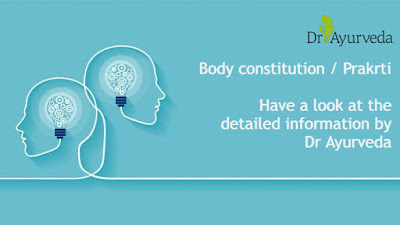Body constitution / Prakrti
Individuals vary in terms of mental, emotional and physical states and capacities. Similarly, all beings have varying proportions of one or more of the three doshas: vata, pitta and kapha. According to the differences of physical characteristics and psychological behaviours, a classification has been made to group individuals based on the proportions of the three doshas present. This is known as their constitution or 'prakrti'.
Prakriti in Sanskrit means ‘nature’. The prakrti is genetically determined and it is dependant on factors such as: the prakrti of the parents at the time of conception, the position of the foetus and the diet/state of the doshas of the expectant mother. Regardless of other factors, prakrti is primarily determined by the doshas.
In Ayurveda, the prakrti plays an important role in one’s health. The knowledge of the prakrti or constitution can guide towards a holistic therapy and thus optimising the individual's wellbeing. For example if someone is susceptible to a particular ailment/disease, then Ayurveda helps to prevent these by choosing the appropriate treatment. It also guides towards the optimal diet and lifestyle for the individual.
Individuals are a combination of all three doshas with a predominance towards one or more. The predominance of two doshas is known as dvandvaja prakrtis. In this situation there will be a mix of the two doshas. The presence of all three doshas in equilibrium is rare and it is known as samadhatu. Below are the seven possible types of prakrtis:
● Vata prakrti
● Pitta prakrti
● Kapha prakrti
● Vata-pitta prakrti
● Pitta-kapha prakrti
● Vata-kapha prakrti
● Sama (vata-pitta-kapha) prakrti
The doshas may be innate/essential (which do not change from birth) and acquired (which change according to internal and external factors). Therefore the predominant dosha of an individual can easily be aggravated. People with more than one predominant dosha will possess the characteristics of both. An Ayurvedic expert should be consulted to determine an individual's prakrti accurately.
Short points:
● All beings have varying proportions of one or more of the three doshas: vata, pitta and kapha
● Prakrti is genetically and primarily determined by the doshas
● The constitution or prakrti of an individual is based on the proportions of the doshas present
● These varying proportions of doshas determines one’s mental, emotional and physical states and capacities - which is what makes every individual unique
● The constitution of the individual is determined at the time of conception (which depends on the predominance of the doshas at this time)
● Individuals are a combination of all three doshas with a predominance towards one or more
● The knowledge of the prakrti or constitution can guide towards a holistic therapy and thus optimising the individual's well being.
Individuals vary in terms of mental, emotional and physical states and capacities. Similarly, all beings have varying proportions of one or more of the three doshas: vata, pitta and kapha. According to the differences of physical characteristics and psychological behaviours, a classification has been made to group individuals based on the proportions of the three doshas present. This is known as their constitution or 'prakrti'.
Prakriti in Sanskrit means ‘nature’. The prakrti is genetically determined and it is dependant on factors such as: the prakrti of the parents at the time of conception, the position of the foetus and the diet/state of the doshas of the expectant mother. Regardless of other factors, prakrti is primarily determined by the doshas.
In Ayurveda, the prakrti plays an important role in one’s health. The knowledge of the prakrti or constitution can guide towards a holistic therapy and thus optimising the individual's wellbeing. For example if someone is susceptible to a particular ailment/disease, then Ayurveda helps to prevent these by choosing the appropriate treatment. It also guides towards the optimal diet and lifestyle for the individual.
Individuals are a combination of all three doshas with a predominance towards one or more. The predominance of two doshas is known as dvandvaja prakrtis. In this situation there will be a mix of the two doshas. The presence of all three doshas in equilibrium is rare and it is known as samadhatu. Below are the seven possible types of prakrtis:
● Vata prakrti
● Pitta prakrti
● Kapha prakrti
● Vata-pitta prakrti
● Pitta-kapha prakrti
● Vata-kapha prakrti
● Sama (vata-pitta-kapha) prakrti
The doshas may be innate/essential (which do not change from birth) and acquired (which change according to internal and external factors). Therefore the predominant dosha of an individual can easily be aggravated. People with more than one predominant dosha will possess the characteristics of both. An Ayurvedic expert should be consulted to determine an individual's prakrti accurately.
Short points:
● All beings have varying proportions of one or more of the three doshas: vata, pitta and kapha
● Prakrti is genetically and primarily determined by the doshas
● The constitution or prakrti of an individual is based on the proportions of the doshas present
● These varying proportions of doshas determines one’s mental, emotional and physical states and capacities - which is what makes every individual unique
● The constitution of the individual is determined at the time of conception (which depends on the predominance of the doshas at this time)
● Individuals are a combination of all three doshas with a predominance towards one or more
● The knowledge of the prakrti or constitution can guide towards a holistic therapy and thus optimising the individual's well being.
 |
| Body constitution / Prakrti |
No comments:
Post a Comment
Note: Only a member of this blog may post a comment.